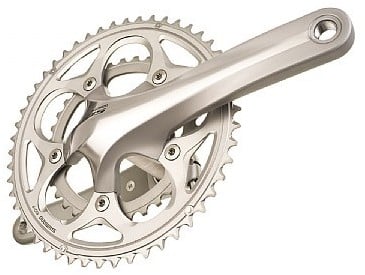All About Gear Inches
 In the days when 10-speed bikes really only had ten speeds, avid riders could reel off gear ratios by heart and often switched out cassettes depending on the terrain of their ride or race. Now, with double and triple cranksets, a single cassette can easily accommodate adequate gearing to cover most any ride.
In the days when 10-speed bikes really only had ten speeds, avid riders could reel off gear ratios by heart and often switched out cassettes depending on the terrain of their ride or race. Now, with double and triple cranksets, a single cassette can easily accommodate adequate gearing to cover most any ride.
"Gear inches" are a holdover from the days of penny farthings. Back then, how fast a bike could go was determined solely by the size of the drive wheel. A 50" diameter wheel could go a certain distance with every pedal revolution; a 60" wheel could go a little farther—and so on. When the safety bicycle (that's more or less the bicycle most of us are familiar with today, with two wheels of the same size) was invented, its chains and sprockets meant that a smaller wheel could be turned faster than the pedal—that is, a 28" wheel, with the right gearing, could conceivably go the same distance with one pedal revolution as a 60" direct-drive penny farthing wheel. That bike was said to be geared at 60 inches.
The gear inches of a particular set-up can be measured with the following equation: the diameter in inches of the drive wheel, times the number of teeth in the front chainring divided by the number of teeth in the rear sprocket. So, if you had your chain on the small ring up front (39 teeth) and a 15-tooth cog in the back, with standard 27" road wheels, you'd have 27 x (39/15) = 70 gear inches.
The smaller the gear inch number, the easier the bike will be to pedal. Small gear inches are great for climbing, while big gear inches will help you go fast on the flats. Mountain bikes usually have a low gear in the 20's in terms of gear inch, while road racing bikes might have a high gear in the low 100's.
The most common gear inch decision that road riders make today is the choice of a standard or compact double crankset. Compact cranksets became popular in the early 2000's, when many riders began using them in the climbing stages of the Tour de France. While a standard double crankset usually has chainrings with 53 and 39 teeth, a compact crankset has chainrings with 50 and 34 teeth. These smaller rings mean more usable gears when the road tilts uphill. Since most recreational riders don't spend that much time hammering across flat terrain or launching break-neck sprints, compact cranksets have become very popular with that set. Functionally, going compact means trading a few top-end gear combos for a lot of useful mid-range ones.
With a 11-25 rear cassette, a standard crankset would provide a gear inch range of about 42-130; a double crankset would provide a range of about 36-122. Most racers will probably find a standard crankset most useful—they need those higher gears.
For all the information about gear inches you could ever need, consult Sheldon Brown's Gear Ratio Calculator.
We carry cranksets from Shimano, SRAM, and Campagnolo; most models are available in standard or compact variations. If you have any questions about gear inches or component selection, feel free to contact us at (503) 917-0156 or [email protected].



















